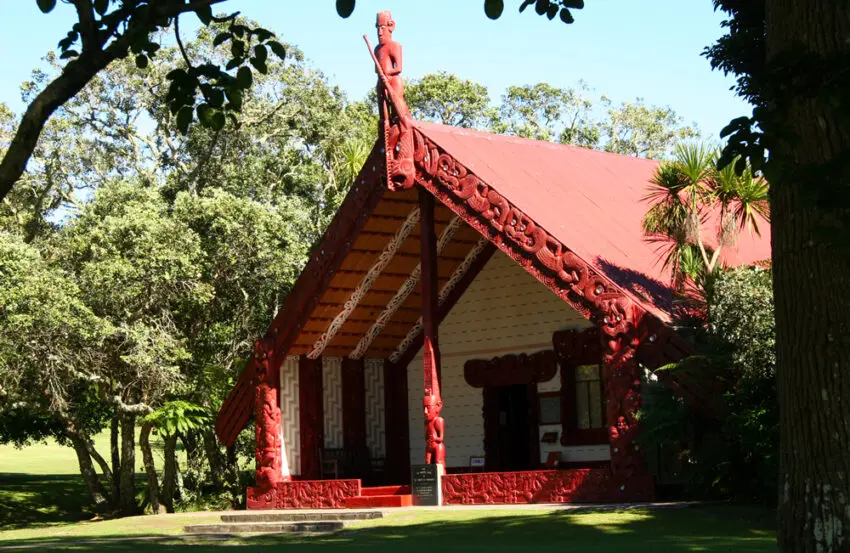The history of Waitangi Treaty Grounds is intricately woven into the culture and identity of Aotearoa New Zealand. Within the grounds are a number of places of historic significance, each with its own story. From the ceremonial flag pole and the carved meeting house to the Waitangi National Trust and the Waitangi Reserve, the grounds are a place of learning and collective reflection.
The Origins of the Waitangi Treaty Grounds
The establishment of the Waitangi Treaty Grounds began in 1840. At this time, Māori and representatives of the British crown came together to sign the Treaty of Waitangi. This landmark document was the first agreement between the two cultures and represented a significant milestone in the relationship between the two peoples.
The treaty was signed on the grounds of the hilltop home of the Māori chief, Te Tii. Here, dozens of Māori chiefs and British representatives gathered to negotiate the terms of the agreement. It is believed that the meeting place was chosen specifically to signify its importance, with the hilltop offering a good vantage point to view the bay below.
The grounds then came under the protection of the Waitangi National Trust, which was established in 1932. The Trust is responsible for the conservation and protection of the grounds, and also organizes events and activities throughout the year.
Notable Structures at Waitangi
The grounds of the Waitangi Treaty Grounds are home to a number of significant structures and monuments. Some of the more notable structures include:
- The Flagstaff: The Flagstaff is an iconic landmark within the grounds. Constructed in 1932, the flagpole is made of Kauri wood and is flew the Union Flag on the day that the treaty was signed in 1840.
- The Carved Meeting House: The Carved Meeting House was built by Māori in the mid-19th century and has been an integral part of the Waitangi grounds ever since. The Meeting House is intricately carved and decorated with the traditional symbols of Māori, and is often used for ceremonial purposes.
The Waitangi National Trust
The Waitangi National Trust is responsible for the conservation and protection of the Waitangi Treaty Grounds. Established in 1932, the Trust is dedicated to preserving the culture and history of the grounds and making it accessible to all.
The Trust’s mission is to provide a visitor experience that is both educational and respectful to the Māori and British cultures who signed the treaty in 1840. The Trust also works to build relationships between Māori and other New Zealanders and create a sacred atmosphere of peace and reflection.
The Trust organizes a variety of events and activities throughout the year. Highlights include an annual commemoration of the signing of the Treaty of Waitangi and a variety of cultural performances and talks. Twice a year, the Trust hosts full-day events that focus on the historic significance of Waitangi. The Trust also provides educational resources and community engagement programs.
The Trust also manages the Waitangi Reserve, which is used for community activities, ceremonies and events. The Reserve is home to the Treaty House, a stunning three-story building that was once the home of Chief Te Tii. The Reserve is surrounded by lush native bush and is a popular destination for visitors to the Waitangi Treaty Grounds.
Preserving and Celebrating the History of Waitangi
The history of the Waitangi Treaty Grounds is one of the most important stories in New Zealand’s history. The Waitangi National Trust is dedicated to preserving and celebrating this history, and making it accessible to all. From its origins in 1840, to the events and activities hosted by the Trust today, the Waitangi Treaty Grounds are a place for the entire nation to come together and reflect on the history and culture of Aotearoa New Zealand.
The Trust is committed to providing a visitor experience that is both educational and respectful. Visitors to the Waitangi Treaty Grounds can expect to experience a variety of cultural performances and talks, as well as engaging educational resources and community engagement programs. Every year, the Trust hosts a number of events to commemorate the signing of the Treaty of Waitangi and celebrate the history of this important site.
The Waitangi Treaty Grounds are a place of learning, reflection, and celebration that can be enjoyed by all. From its origins as the site of a historic meeting between Māori and British cultures, to its current role as a site of celebration and education, the Waitangi Treaty Grounds provide an important and unique insight into Aotearoa New Zealand’s history.

